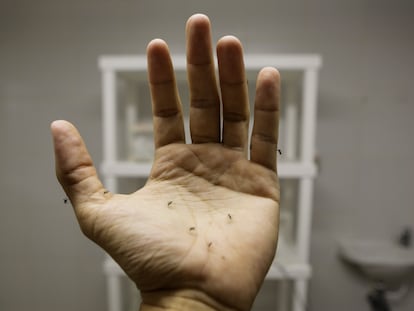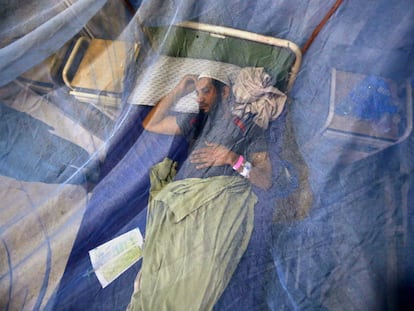Dengue in Latin America: How it spreads and how to avoid it
From Mexico to Brazil, cases of dengue have increased. Climate-related factors have provoked an epidemic in the region

Since 2022, Latin America has seen a significant increase in cases of dengue, and dengue-related deaths, compared to previous years. According to the Pan American Health Organization (PAHO), climate-related factors have caused it to spread in multiple countries in the south, center and north of the continent.
The mosquito that spreads dengue, Aedes aegypti, has been in the Americas for five centuries, since ships transported enslaved people from Africa to the New World on a voyage that lasted a little more than two months. The insect matures from an egg to a mosquito over seven to 10 days and lives up to a month. Today, it spreads fatal diseases in Latin America and part of the United States, including dengue, yellow fever, sika and canine dirofilariasis. Dengue was first identified by the Swahili people in Eastern Africa, who describe it as an attack similar to cramps or chills. It is characterized by high fever and muscle pain that can be fatal.
The PAHO’s epidemiological report indicates that a variant of the insect, the Aedes albopictus or tiger mosquito, also exists in the Southern Cone, Central America and part of Mexico and the southern United States. This species has some resistance to insecticides and chemicals, according to the observations of specialists from the Medical Entomology department of Japan’s National Institute of Infectious Diseases.
How is dengue spread?
It is contracted through a bite from a female mosquito. By extracting blood from humans, the insect feeds its eggs, which it lays in places with standing water in containers like buckets, cups, planters, flower vases and water dishes for pets. During its life cycle, the mosquito can lay up to five dozen eggs.
How can dengue transmission be prevented?
The PAHO’s recommendations to prevent dengue include eliminating potential egg-laying sites from homes and common areas; reorganizing trash collection services; and defining the areas of high risk to prioritize those with crowds of people, including schools, transportation terminals, hospitals and health centers.
In addition to those suggestions, federal governments, including that of Colombia, recommend the use of repellent on uncovered body parts; wearing long sleeves and long pants; using mosquito nets at home; refilling unused septic tanks or drains; picking up trash and keeping open spaces clean.
Brazil
Cases of dengue in Brazil have proliferated since December 2022. Two factors contributed to its spread: last year’s heavy rains and the increase in temperatures caused by climate change. The latest data from the Ministry of Health indicate that, in 2021, there were more than 1.4 million cases in the country, leading to 980 deaths.
The Ministry’s projections for this year are worse: it could reach more than 1,000 deaths, almost three per day.
Most of the cases are concentrated in the center-west and southern regions, according to Infodengue, an alert system based on hybrid data generated through analysis of social networks, climate and epidemiological data. The states with the highest rates of contagion are São Paulo, Mato Grosso do Sul, Mato Grosso and Amazonia.
Argentina
One of the Argentine government’s key health goals is the elimination of dengue. By mid-May 2023, according to official data, 39 people had died from dengue. The authorities, through the National Administration of Drugs, Food and Medical Devices, approved the use of the vaccine against the disease.
The vaccine’s active ingredient is made by the Japanese laboratory Takeda, which has the patent on Riopan. Two doses will be administered over a period of three months to everyone over four years old, whether or not they have previously contracted the disease.
The vaccine, according to the Japanese laboratory, is named TAK-003 or Qdenga. It protects against all of the virus’s serotypes with an effectiveness of up to 80%.
Until a little more than a month ago, when its last epidemiological report was published, Argentina had registered 56,324 cases of dengue. 92% of cases occurred in 13 of its 23 provinces. As in neighboring countries, the increase in temperatures is a contributing factor. The country currently faces a heat wave that could be the longest it has experienced in over a century.
Bolivia
Bolivia is also a focal point for Latin America’s dengue epidemic. In Santa Cruz de la Sierra, a city to the southeast of La Paz, the Andean country’s capital, 11 dengue deaths had been registered by February of this year, including three babies.
At that time, citizens demanded that Luis Arce’s government declare a health emergency, which it did not do.
Mexico
Mexico is not an exception when it comes to the spread of dengue. The Mexican government, which has an actively updated calendar that tracks cases of the disease, had documented 2,420 active cases for the week of May 8, including three deaths. The same report details that only 10 of the country’s 32 states have not reported cases: Aguascalientes, Baja California, Chihuahua, Coahuila, Mexico City, Mexico State, Guanajuato, Querétaro, Tlaxcala and Zacatecas.
“If the virus attacks the circulatory system and causes shock and internal bleeding, it can cause death in hours. Dengue acts very quickly,” said Luis del Carpio, a virologist and internist, in an interview with EL PAÍS. He added that the disease’s mortality rate has increased as it becomes more resistant and spreads to regions where it did not previously exist.
The weekly report indicates that all possible serotypes exist in Mexico. 85% of confirmed cases are in Quintana Roo, Yucatán, Veracruz, Guerrero, Tabasco and Chiapas, which have a climate that is apt for mosquitos.
What is happening with dengue in the Southern Cone, Central America and the Andean region?
Since 2007, the epidemic has grown in South America, starting in Paraguay and extending to neighboring nations including Brazil, Argentina and Uruguay. Now, 16 years later, Chile has also issued health alerts in seven of its states, as it detected the insects last week.
According to the PAHO’s latest epidemiological report, the Southern Cone had around 84.65 cases for every 100,000 residents. The Andean region had 78.55 cases for every 100,000, and Mexico and the Central American isthmus reported 18.77 cases per 100,000 residents.
Sign up for our weekly newsletter to get more English-language news coverage from EL PAÍS USA Edition
Tu suscripción se está usando en otro dispositivo
¿Quieres añadir otro usuario a tu suscripción?
Si continúas leyendo en este dispositivo, no se podrá leer en el otro.
FlechaTu suscripción se está usando en otro dispositivo y solo puedes acceder a EL PAÍS desde un dispositivo a la vez.
Si quieres compartir tu cuenta, cambia tu suscripción a la modalidad Premium, así podrás añadir otro usuario. Cada uno accederá con su propia cuenta de email, lo que os permitirá personalizar vuestra experiencia en EL PAÍS.
¿Tienes una suscripción de empresa? Accede aquí para contratar más cuentas.
En el caso de no saber quién está usando tu cuenta, te recomendamos cambiar tu contraseña aquí.
Si decides continuar compartiendo tu cuenta, este mensaje se mostrará en tu dispositivo y en el de la otra persona que está usando tu cuenta de forma indefinida, afectando a tu experiencia de lectura. Puedes consultar aquí los términos y condiciones de la suscripción digital.
More information
Archived In
Últimas noticias
ChatGPT fails the test: This is how it endangers the lives of minors
The late consecration of women artists in their 90s
The Florida Keys tourist paradise is besieged by immigration agents: ‘We’ve never seen anything like this’
The latest scam on WhatsApp behind the legal dream: using immigration status as bait
Most viewed
- Families demand repatriation of bodies of Colombians who died in Ukraine: ‘This war is a slaughterhouse for foreigners’
- The low-cost creative revolution: How technology is making art accessible to everyone
- Liset Menéndez de la Prida, neuroscientist: ‘It’s not normal to constantly seek pleasure; it’s important to be bored, to be calm’
- Christian Louboutin: ‘Young people don’t want to be like their parents. And if their parents wear sneakers, they’re going to look for something else’
- ‘El Limones’ and the growing union disguise of Mexican organized crime










































